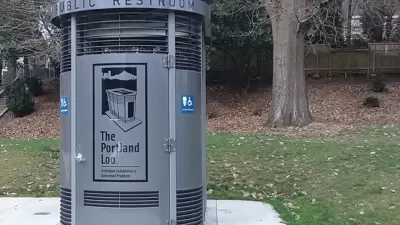In 2006, New York City signed contracts for private-public partnerships that would deliver a variety of street furniture throughout the city. To date, 3,355 bus shelters, 304 newsstands, and three (3) public toilets have been built.
Sam Roberts reports on the slow pace at which a Spanish company called Cemusa, working with the Department of Transportation, has been able to site and install public toilets in New York City.
Here is what has sufficed for progress so far: “The first toilet was installed in Madison Square Park early in 2008, followed by one in Corona, Queens, later that year. The third was placed in Grand Army Plaza, Brooklyn, in 2011.”
“If installation continues at this rate, the 20 automatic toilets for which the city sought bids fully a decade ago will be functioning by about 2065. Of course, even 20 toilets, for a city that swells to nearly 10 million with commuters on a typical weekday, would mean one such facility would serve nearly 500,000 people,” writes Roberts.
As for why it’s been so difficult to install public toilets, despite popular demand: “a number of neighborhoods have responded to the toilets with a not-in-my-backyard indifference, at best,” and “no lavatory lobby has ever materialized.”
Some in New York expected these problems from the outset, and other cities have also found public toilet programs difficult to implement and expensive, at best.
FULL STORY: In 9 Years of Work, Just 3 Public Toilets Go Live

Alabama: Trump Terminates Settlements for Black Communities Harmed By Raw Sewage
Trump deemed the landmark civil rights agreement “illegal DEI and environmental justice policy.”

Planetizen Federal Action Tracker
A weekly monitor of how Trump’s orders and actions are impacting planners and planning in America.

Why Should We Subsidize Public Transportation?
Many public transit agencies face financial stress due to rising costs, declining fare revenue, and declining subsidies. Transit advocates must provide a strong business case for increasing public transit funding.

Understanding Road Diets
An explainer from Momentum highlights the advantages of reducing vehicle lanes in favor of more bike, transit, and pedestrian infrastructure.

New California Law Regulates Warehouse Pollution
A new law tightens building and emissions regulations for large distribution warehouses to mitigate air pollution and traffic in surrounding communities.

Phoenix Announces Opening Date for Light Rail Extension
The South Central extension will connect South Phoenix to downtown and other major hubs starting on June 7.
Urban Design for Planners 1: Software Tools
This six-course series explores essential urban design concepts using open source software and equips planners with the tools they need to participate fully in the urban design process.
Planning for Universal Design
Learn the tools for implementing Universal Design in planning regulations.
Caltrans
Smith Gee Studio
Institute for Housing and Urban Development Studies (IHS)
City of Grandview
Harvard GSD Executive Education
Toledo-Lucas County Plan Commissions
Salt Lake City
NYU Wagner Graduate School of Public Service





























